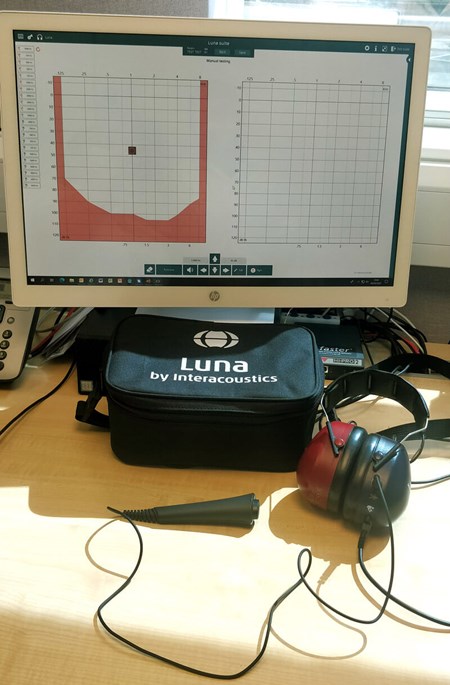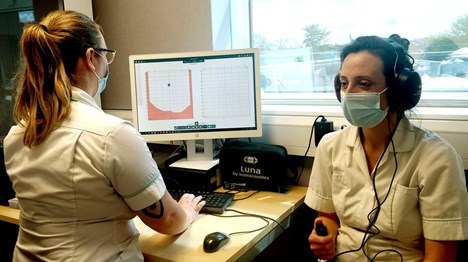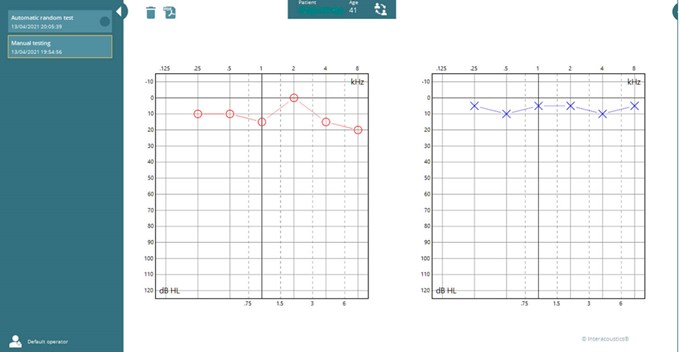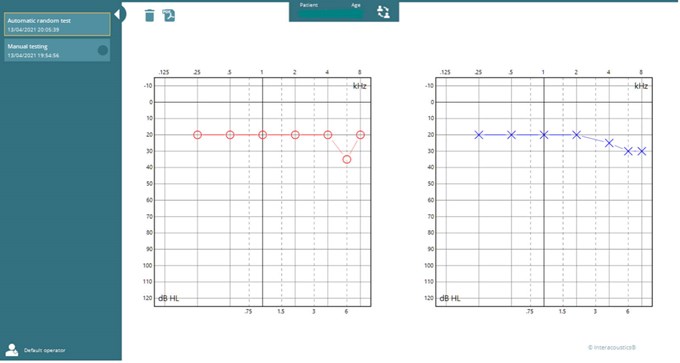
“The professional grade headset designed with screening in mind.” Interacoustics Luna – does it ‘eclipse’* the competition?*
* (Although we are fans of moon-based puns, this is not to be confused with Interacoustics’ other stellar device, the Eclipse Evoked Potentials system.)
The Interacoustics Luna is an intriguing device – a pair of red and blue circumaural headphones that connects to a Windows PC or tablet via USB, with a response button emerging from the headset itself rather than being a separate USB plug in. When paired with the lightweight software (only 11.2MB at the time of writing), it allows for air conduction (AC) hearing testing through either an automated screen or manual test procedure.


As a screening Type 4 audiometer (in accordance with IEC60645-1), this is not going to be suitable for a diagnostic clinic setup and, from Interacoustics’ marketing, it appears to be designed to be portable, fast and reliable for those who may be doing school or workplace hearing screenings. However, as audiologists, our initial inclination was to experiment with the manual test method to see whether an AC hearing test could be performed following the BSA standard procedures. On the whole, the Luna provides an intuitive experience for any trained audiologist and, if you are used to different manual controls, they can be re-mapped to whatever is familiar. Likely owing to the limited power that can be delivered over USB, the Luna cannot produce very high levels of sound and so is not suitable for testing those with a severe-profound hearing loss.
“As a screening tool, the Luna performed quickly with randomisation ensuring attention was maintained, however it needs a trained audiologist to be present while the test runs”
When turning to the automatic testing, which the Luna appears more geared towards, you are offered the option of a randomised or a sequential testing method. The randomised method simply randomises the test ear and test frequencies when presenting, while the sequential method follows either the default or a user-programmed testing sequence of frequencies. Otherwise, the test parameters are the same. The Luna will only test between a pre-specified threshold range (e.g., 20-60dB HL), which can be modified within the test settings. You can also change other parameters, such as the tone presentation time, the response window and the stimulus type. Once testing begins, the Luna will begin presenting at the lower end of the threshold and, after a response window and a randomised gap of silence, increase the presentation level by a specified amount and present again. If a button press is registered within the response window, a threshold value will be recorded. It is worth noting that only one response is required to register a response.

Manual pure tone audiometry following Hughson-Westlake procedure on Mr Ellis.

Automatic random screening test using pre-set definitions on Mr Ellis.
A trial run was tested on Mr Ellis, who agreed to try the Luna’s audiometry settings on the Automatic Random Test, and the Manual Testing mode with Mrs Ellis leading the proceedings. It was easy enough to change stimulus to account for his tinnitus, and we first ran a manual test to get a good baseline following the well-engrained Hughson-Westlake test method. Manual testing identified some difficulty with the high frequencies because of tinnitus, but reliable and repeatable responses were soon obtained following the BSA recommended procedure of accepting 2/2 or 2/3 responses.
Automatic Random Test mode was run and the difference in the high frequencies recorded was noticeable considering that only one response is required to store a result in the audiogram. As a screening tool, the Luna performed quickly with randomisation ensuring attention was maintained, however it needs a trained audiologist to be present while the test runs. One difficulty here is that there is no indicator to signal the presentation tone, you are relying purely on patient response.
“With a suitable laptop or tablet, you have all the equipment you need to enter a school, workplace or GP surgery and provide calibrated, effective hearing screening”
From our observations of the automatic testing procedure, we have observed the benefits of the simple and automated test process that the Luna provides. With suitable settings pre-programmed for the testing procedure, a tester could perform a calibrated pure tone threshold hearing screening with minimal training. The headsets provide suitable sound dampening to be done outside a sound booth in a relatively quiet settings, which could be a spare room in a school or workplace setting. However, the human element of testing is still important, even with this automated test; because the automated procedure requires only one button press to accept a response, it leaves the door open for accepting erroneous or fabricated button presses. For someone with a significant hearing loss, the incremental increase in sound amplitude may result in long gaps between audible sound presentations, which will increase the risk of false responses. The test procedure will also fall foul of the trigger-happy button pressers of the paediatric population. Therefore, having the tester keeping an eagle eye on the subject during testing is recommended. One sorely missed feature is an indicator (flashing light or icon) for the tester to see when a signal is being presented so that they can verify if responses are correctly correlating with presentations, so they can more accurately discount false responses and provide reinstruction if needed.
One final point that affected us during our initial trials with the software was the need for suitably fast hardware. The Luna’s system requirements specify a Windows Operating system (7+) as well a processor speed of at least 2GHz and a minimum of 2GB of RAM. That means that operating on more lightweight or older hardware may be a problem, like it was on the first device we tried, which had delays for the patient response during the manual testing procedure. The benefit of running on a separate device is the ability to maintain a database of clients that can be opened even without the Luna plugged in for report generation or to deliver results. While Interacoustics promotes running the software on a tablet, it should be stressed that this will not work on an iPad or Android tablet at the present time as it requires the Windows operating software to function.
Overall, we can see the clear benefits of the Luna for anyone operating a portable hearing screening service. With a suitable laptop or tablet, you have all the equipment you need to enter a school, workplace or GP surgery and provide calibrated, effective hearing screening. You can tailor the screening window for the automated test to whatever parameters you wish and away you go. For many, the absence of bone conduction, masking and high intensity testing will not be important for the type of testing they provide, and they will find the Luna an excellent alternative to existing screening equipment, which does not have its own stand-alone software and database. As mentioned earlier, the human element will still be important for observing the testing procedure, but professionals who go in with their eyes open may find themselves over the moon at what the Luna can offer them.





